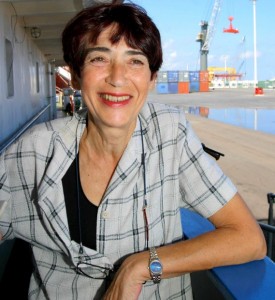Paulina Zelitsky
Zelitsky, Paulina
Paulina Zelitsky was born in Poland and studied engineering in the former Soviet  Union. During the Cold War she worked on a submarine base in Cuba but defected to Canada, where she married Paul Weinzweig and together set up a company called (ADC). The company specialises in deep-sea exploration. The Cuban government had employed them to assist in the location of sunken treasure that is believed to lie off the coast in a variety of vessels.
Union. During the Cold War she worked on a submarine base in Cuba but defected to Canada, where she married Paul Weinzweig and together set up a company called (ADC). The company specialises in deep-sea exploration. The Cuban government had employed them to assist in the location of sunken treasure that is believed to lie off the coast in a variety of vessels.
In 2001, they announced the discovery of megalithic structures 9 km off Cabo San Antonio on the western tip of Cuba, in water half a mile deep. The expedition was a joint venture between ADC, the National Geographic Society and the Centre for Marine Archaeology and Anthropology at the Cuban Academy of Sciences in Cuba. Subsequent announcements included a claim that inscriptions had been found on some of stones that appear vaguely similar to Greek. Other carvings seem to be related to Central American symbols including what is sometimes referred to as the Central American Cross. Cuban academics are studying these incisions. It has been suggested that the US State Department applied pressure on The National Geographical Society to withdraw a promise of two million dollars to fund further investigations because of US Administration’s antipathy towards Cuba at that time. Later that year Zelitsky gave an interview to Linda Moulton Howe that can be read online(a).
In late 2004, Zelitsky led a team to explore the sea floor between the Yucatan peninsula and Cuba where sonar reading had suggested manmade structures. Apparently they think that an island was submerged ten or twelve thousand years ago as a result of seismic activity.
May 2013 saw Zeilitsky and Weinzweig attempt to reprise the attention that they received when they first made their claim a dozen years earlier. A recent interview(b) with journalist Luis Mariano Fernandez has Zeilitsky rehashing her original claim with the addition, perhaps by Fernandez, of the old story of a glass pyramid in the Bermuda Triangle touted by the late Ray Brown.
A more critical review of the Zeilitsky-Weinzweig claims is to be found on the Bad Archaeology website(c).
(b) https://wolfke74.wordpress.com/2013/05/31/atlantis-found/
(c) https://badarchaeology.wordpress.com/2012/10/28/an-underwater-city-west-of-cuba/
Cuba *
Cuba is a Caribbean island favoured by some as a serious contender for the location of Atlantis.
” A two-page article appeared in the February 1952 edition of the magazine ECOS entitled ’Formó Cuba Parte de la Atlándida?’. Written by Francisco Garcia-Juarez, the press secretary of the Instituto Cubano de Arqueologia (Institute of Cuban Archaeology, or ICA) it posed the question: did Cuba once form part of Atlantis? He explained how members of the Institute were investigating the idea that traces of an Atlantean culture might be found in Cuba and Hispaniola.” This study had been prompted by a suggestion from Egerton Sykes(e).
Some years ago, Leicester Hemingway, the brother of Ernest, claimed to have spotted off the northern coast of Cuba “an expanse of stone ruins, several acres in area”.
 In more recent years, it was reported that Paulina Zelitsky and her team of underwater explorers found formations, in 2000 feet of water off the western tip of Cuba that resembled submerged cities.
In more recent years, it was reported that Paulina Zelitsky and her team of underwater explorers found formations, in 2000 feet of water off the western tip of Cuba that resembled submerged cities.
Although there was a widespread media reaction to Zelitsky’s discovery, many commentators drew parallels with Plato’s city of Atlantis. However, Zelitsky was unwilling to make such comparisons. The story is a myth, said Zelitsky.“What we have found is more likely remnants of a local culture”, once located on a 100-mile “land bridge” that joined Mexico’s Yucatan Peninsula with Cuba.
Although further explorations were planned it is reported that the U.S. government applied pressure to have any further funding denied. May 2013 had Zelitsky trying to revive interest in her theories in an interview with Luis Mariano Fernandez(d). However, in 2012, Andrew Collins offered a different account of the Zelitsky funding difficulties(g).
Barry Warmkessel, who is normally just concerned with the threat to Earth posed by asteroids and comets, digressed slightly in an illustrated paper updated in 2015(l). He discusses in great detail the possible destruction of Atlantis by a comet/asteroid impact off the west coast of Cuba.
Andrew Collins is probably the best-known supporter of a Cuban Atlantis. His book[072] and website(a) list eleven points in favour of this theory. He contends that Cuba’s western plain, which stretches from Havana westwards to Pinar del Rio was the great Plain of Atlantis described by Plato. He believes that the main city was located near the present Isle of Youth (Isla de la Juventud) situated in the south of the island. In 2009 Norman Frey wrote a paper(b) supporting the Gulf of Batabanó which lies north of the Isle of Youth as Atlantis’ location at the end of the last Ice Age. He supports his contention with satellite images and the work of Dr Christine Pellech. Frey also claims that the two plains of Cuba match Plato’s description of the Plain of Atlantis(k).
A.R.E. is also a supporter of Cuba as a possible location for the capital of Atlantis. They have suggested an underwater ‘island’ at Zapata, located on the southern side of Cuba, north of the Isle of Youth and just to the west of the infamous Bay of Pigs. This ‘island’ is surrounded by a small ring of water and is about 7 miles in diameter, consistent with Plato’s description of the outer ring of Atlantis. A.R.E.’s Greg Little obtained old depth and bottom contour charts of the site and found that the island was comprised of a series of rings. Little also identified other features in the locality that match Plato’s story; ancient manmade canals north of the underwater island. These canals have been attributed to the Taino Culture, a mound-builder culture present in Cuba about 3,000 years ago that became extinct shortly after the Spanish conquest. Further north there is a mountain range enclosing the area with a wide river running at its base — a further match with Plato. Little also found that the centre of the underwater island is not only the tallest portion but also has several springs on it.
One completely off-the-wall suggestion has been that the Cuban Missile Crisis was instigated to prevent the Soviets from finding Atlantis(f)!!
A project to compile an archaeological Atlas of Cuba has so far identified over 3,000 pre-Columbian sites. Cuba’s westernmost province, Pinar del Rio and the central region of Villa Clara have the highest density of sites, with 500 each(c).
Gerard W.J. Janssen of Leiden University places the voyages of Odysseus in the Atlantic(i). However, although he situates most of the places visited in the eastern Atlantic he does claim(h) that Homer‘s Laestrygonians were to be found in Cuba, an interpretation supported by both Théophile Cailleux and Iman Wilkens.
Luigi Usai has recently (2022) published a number of images purporting to show underwater anomalies off the coast of Cuba(j). As Usai has already designated the central region of the Mediterranean as the location of Atlantis I cannot understand his reason for showing such images. Similar anomalies have been found in various parts of the world and explained by Google as data-gathering glitches (see Satellite Imagery). If any of the rectangular features were city walls or streets they would have been kilometres wide – a nonsensical suggestion.
(a) https://www.andrewcollins.com/page/news/Atlantisfile.htm
(b) https://www.migration-diffusion.info/article.php?id=162
(c) Archive 2952 | (atlantipedia.ie) *
(d) https://wolfke74.wordpress.com/2013/05/31/atlantis-found
(e) https://thewadeword.wordpress.com/tag/bimini/
(f) Archive 2462
(g) https://www.abovetopsecret.com/forum/thread374842/pg11
(h) LAISTRUGONIACUBA, LA HAVANA (homerusodyssee.nl)
(i) https://www.academia.edu/38535990/ATLANTIC_OGUGIA_AND_KALUPSO?email_work_card=view-paper
(j) Cuba high resolution bathymetry – Atlantis exists! Found by Dr. Luigi Usai (atlantisfound.it)
(k) The level of Atlantis – Atlantisforschung.de (atlantisforschung-de.translate.goog)
(l) THE ATLANTIS CATASTROPHE – Plato Was Right (archive.org)
